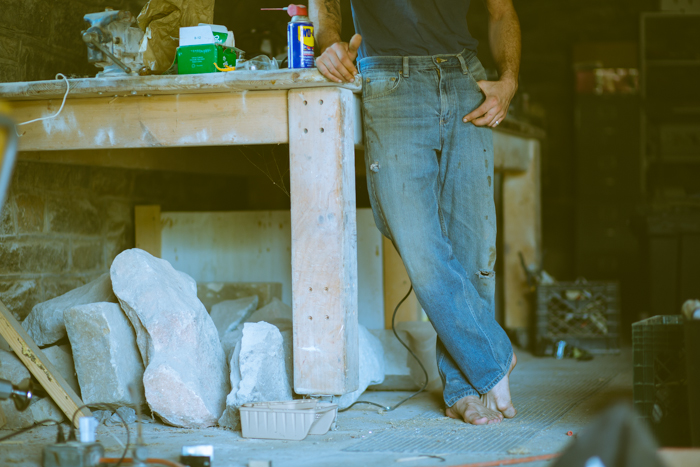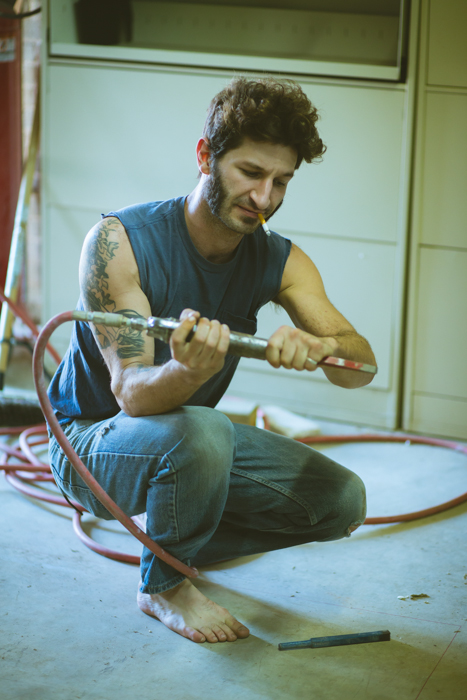Not quite a ShutterTrip, since it doesn't cover down to the gritty level of process -- however I absolutely love meeting and photographing people and learning about a world outside my own. When I worked as a gallery docent, I got the privilege of also writing about it. Meet Justin Blowers of Asheville, NC -- sculptor extraordinaire.
--

--
Justin Blowers – a young and edgy sculptor trained in the traditional manner of
cathedral restoration, instead of following the typical procedure of college, he pursued what he
wanted to learn more about. Riding his bike past a shop that advertised apprenticing,
he decided to pursue it. He began to learn about the process and fell in love with it. He
apprenticed under various master carvers in Cape Cod, California, and Florida.
Though he loves sculpture, he wants to ultimately have more time to focus on all types
of art, i.e. “music, or weird unusual stuff.” He strives to have a life that emulates
balanced Renaissance Man artists, where one is a master of several different types of
focuses.

I drive through the rusted industrial gate into an abandoned warehouse yard, calling
Justin to make sure I’m in the right place. “Oh I see ya – let me throw on a shirt, I’ll
be right down.” He bounds, clad in jeans and a cut-off t-shirt, down metal stairs that
run outside from his second-story apartment down to the level of his workshop. He
shakes my hand with a tatted arm, and proceeds to lead the way to his shop. We
walk into a large space, shelved with tools and various stone materials. A large
ornate fireplace mantle is laid out on the floor, mostly in straight block pieces to be
assembled later. Lighting a cigarette, he pops down on a low workbench and props
his bare feet up on another.
While I set up my laptop on a dusty worktable, I ask about his style. “It was mostly out of rebellion of the day job where I got tired of carving straight lines that are only to fulfill a specific purpose. I like curves.” (His day job, being architectural restorations, fabrications and installations).
In fact, he off-handedly remarks about his two different studio spaces being the left and right brain – one for bringing home the bacon, and the other for refilling his artistic cup. The other shop, though smaller in size, is similar in clutter – dust, tools, smaller stones that are left over from his architectural jobs. “A perk,” he says, as he gets most of his play-materials for free, ranging in origins from India and China to quarries in Georgia.

He continues on about his heavy influences, such as Brancusi, and how in that day and age, sculptors would strive for accuracy; people wanted to be immortalized, so they would commission a statue of them. Brancusi went against this by carving the mere essence of things in a more impressionistic manner.
It’s this essence that chagrins him to name his work – he wants the viewers to have the freedom to see what they will, regardless of his intent. “I almost don’t want to name it at all. If it were up to me, I wouldn’t name it at all, but when I have to, I try to give them ambiguous names.” For instance, regarding Persia, “Some people see a wing, others see an antler...one of my buddies thought it was a beer bottle opener. So be it, but since I had to name it, I named it that because it’s made out of one of the last quarried of that type of Persian granite.”
While I set up my laptop on a dusty worktable, I ask about his style. “It was mostly out of rebellion of the day job where I got tired of carving straight lines that are only to fulfill a specific purpose. I like curves.” (His day job, being architectural restorations, fabrications and installations).
In fact, he off-handedly remarks about his two different studio spaces being the left and right brain – one for bringing home the bacon, and the other for refilling his artistic cup. The other shop, though smaller in size, is similar in clutter – dust, tools, smaller stones that are left over from his architectural jobs. “A perk,” he says, as he gets most of his play-materials for free, ranging in origins from India and China to quarries in Georgia.

He continues on about his heavy influences, such as Brancusi, and how in that day and age, sculptors would strive for accuracy; people wanted to be immortalized, so they would commission a statue of them. Brancusi went against this by carving the mere essence of things in a more impressionistic manner.
“Instead of carving a bird, I’ll carve a shape that reminds you of a bird.”
It’s this essence that chagrins him to name his work – he wants the viewers to have the freedom to see what they will, regardless of his intent. “I almost don’t want to name it at all. If it were up to me, I wouldn’t name it at all, but when I have to, I try to give them ambiguous names.” For instance, regarding Persia, “Some people see a wing, others see an antler...one of my buddies thought it was a beer bottle opener. So be it, but since I had to name it, I named it that because it’s made out of one of the last quarried of that type of Persian granite.”
 |
| "Treble Clef" and "Verde" -- Photos used by Permission from JustinBlowers.com |
Hardly ever sketching beforehand, his freedom with his sculpting is what keeps it
interesting. Rarely does he ever put thought to what the ancient rock will become,
but instead forms a relationship and spends anywhere from 3 to 6 hours at a time
working on it, the majority of it sitting and looking at it, or getting distracted. One
piece will take anywhere from 3 to 6 months. He very rarely works on a piece
straight through, but if he did, it would take him about 2 to 3 weeks. Each piece
requires different techniques, understandably, so that usually doesn’t work out
anyway.
For instance, granite is harder on chisels than limestone or marble, making the process more intensive; it also generally needs the assistance of another stone company’s water polisher. He walks me through the process, digging through tool bags, and showing me various ticks of the trade; right angle grinders, pneumatic hammers, chisels, sanders, heavy-duty sandpaper and diamond polishing pads. He’ll hone it, polish it, or leave sections rough. He’ll then apply it with high strength epoxy, made specifically for stone, to the piece he chose to be the base.

For something that has taken thousands of years to form, shaping it is a source of
happiness and fascination for Justin.
-T
JUSTINBLOWERS.COM
For instance, granite is harder on chisels than limestone or marble, making the process more intensive; it also generally needs the assistance of another stone company’s water polisher. He walks me through the process, digging through tool bags, and showing me various ticks of the trade; right angle grinders, pneumatic hammers, chisels, sanders, heavy-duty sandpaper and diamond polishing pads. He’ll hone it, polish it, or leave sections rough. He’ll then apply it with high strength epoxy, made specifically for stone, to the piece he chose to be the base.

“The stones I shape will last for centuries in their own nature, long after I am gone.”
-T
JUSTINBLOWERS.COM